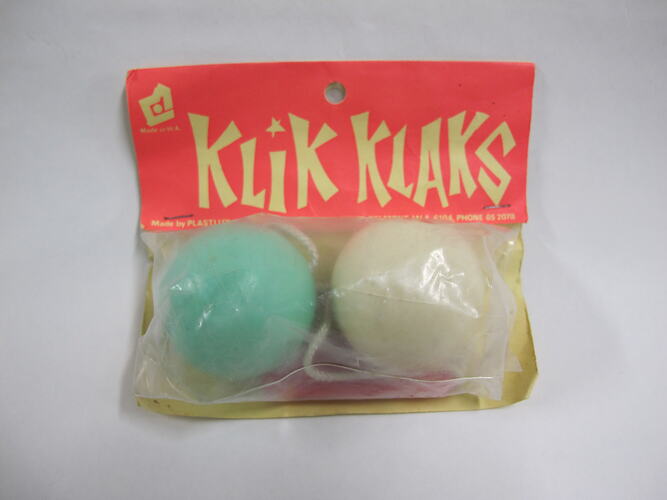Summary
Alternative Name(s): Klackers, Knockers, Yakkers, Bolos
Game of 'Klik Klaks' in original packaging, with instructions for use on the reverse. The user needs to adjust the cords to an equal length, place the holder between the thumb and forefinger, and move hands up and down to create 'gentle knocking motion and gradually increase momentum'.
The game was made in Western Australia, possible under licence from Creative Decorative Co. Inc. in the USA, which used very similar packaging including the same font at the top front. It is likely to date from the klik klak craze of the early 1970s, but it was popular in earlier years too - in 1950 140 cartons of kilk-klak games were imported to Australia.
In 1971 department store David Jones advertised klik klaks in The Canberra Times: 'Klik-klaks, yakkers or clackers, knockers or bolos, as they're variously known, have taken over where the yo-yo left off. You'll hear klik-klaks in your sleep, at the breakfast table, in the buses, and almost everywhere else. Klik-klaks are two small, round balls of special high-impact, shatterproof plastic, suspended from a half inch curtain ring, by two lengths of nylon cord, 8 or so inches long. To embark upon this road to insanity, you simply lift one of the halls to one side and let it fall against the other. The balls collide, bounce away and collide again - that's when you hear it... the noise! Clack, clack - however, when you become expert, the balls collide with such force that they fling them selves in a complete semi-circular blur, setting up a frightful racket, clacketyak-clacketyak-clacketyak. And not only children are wild about them. In a choice of red, green, blue or yellow balls, they are but 69c, from the Toy Department...'
It suggests 'Orbiting around the world' (360 degree spinning), 'Cruising' (running while spinning), 'Blind orbit' (behind back), 'Single orbit', 'Double orbit', 'Rendezvous' (handing to another person) and 'Splash down' (probably hitting a surface).
The game was used as a prop in the 'House Secrets' exhibition at Scienceworks, 6 March 2006 to 14 July 2013. Most of the props for the exhibition were sourced from opportunity shops in 2002 and 2003 by curator Andi Horvarth and other Museum Victoria staff. 'House Secrets' aimed to 'Explore the science behind all the familiar things in our homes', presenting 'all sorts of wonderful things we might find around the home, from the food we eat, to the appliances we use, to the animals we share our living space with.' The exhibition was 'highly interactive'.
Physical Description
Game of 'Klik Klaks' in original plastic package. The game comprises two turned wood balls, one painted white and the other pale green. The are joined by a white string with a red plastic tab at the centre. They are housed in a clear (now clouded) plastic wrap, stapled to a lightweight yellow cardboard backing, printed in pink. The packaging is folded down over the top opening of the plastic. The name of the game, 'KLIK KLACKS' is inscribed large on the front; on the reverse of the cardboard is a series of line drawings and instructions for use.
More Information
-
Collecting Areas
-
Acquisition Information
Transfer from Exhibition Collection Management (ECM), Museum Victoria, Dr Andrea Horvath - Museum Victoria, 23 Jun 2003
-
Place & Date Made
-
Inscriptions
Printed on front: 'Made in W.A. / KLIK KLAKS' [maker's details follow]. Printed on back: suggested games, and 'SIMPLE INSTRUCTIONS': '1. ADJUST CORDS TO EQUAL LENGTH. / 2. PLACE HOLDER BETWEEN THUMB / AND FOREFINGER. / 3. MOVE HANDS UP AND DOWN TO / CREATE GENTLE KNOCKING / MOTION AND GRADUALLY / INCREASE MOMENTUM.'
-
Classification
-
Category
-
Discipline
-
Type of item
-
References
Advertising. (1971, June 17). The Canberra Times (ACT : 1926 - 1995), p. 17. Retrieved August 11, 2015, from [Link 2]">[Link 1] Advertising. (1971, June 17). The Canberra Times (ACT : 1926 - 1995), p. 17. Retrieved August 11, 2015, from [Link 2]">[Link 1]
-
Keywords


